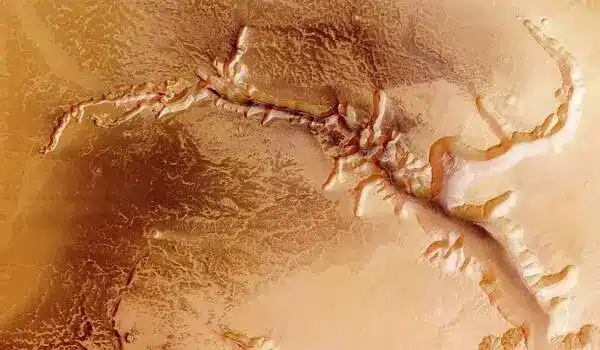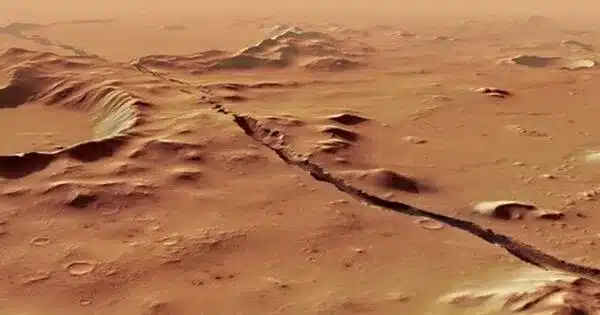Scientists have released the findings of an unprecedented partnership to investigate the cause of the greatest seismic event ever recorded on Mars. The study eliminates out a meteorite collision, implying that the quake was caused by massive tectonic forces under Mars’ crust.
A global team of scientists has announced the findings of an unprecedented collaboration to investigate the cause of the greatest seismic event ever recorded on Mars. The study, sponsored by the University of Oxford, rules out a meteorite impact and instead suggests that the quake was caused by massive tectonic forces under Mars’ crust.
The 4.7 magnitude quake, which caused vibrations to ricochet through the globe for at least six hours, was recorded by NASA’s InSight lander on May 4, 2022. Because its seismic signature was comparable to earlier quakes known to be generated by meteoroid impacts, the team suspected that this event (named ‘S1222a’) was also caused by an impact and initiated an international hunt for a new crater.
Although Mars is smaller than Earth, it has a comparable terrestrial surface area due to the absence of seas. Dr. Benjamin Fernando of the University of Oxford led the project, which solicited contributions from the European Space Agency, the Chinese National Space Agency, the Indian Space Research Organization, and the United Arab Emirates Space Agency. It is believed that this is the first time that all missions in orbit around Mars have worked together on a single assignment. Each group reviewed data from their Mars satellites to check for a new crater or any other tell-tale evidence of an impact (for example, a dust cloud appearing hours after the quake).
This experiment shows how important it is to maintain a diverse set of instruments at Mars, and we are very glad to have played our part in completing the multi-instrumental and international approach of this study.
Dr. Daniela Tirsch
After months of digging, the team stated today that no new craters had been discovered. They come to the conclusion that the event was triggered by the release of massive tectonic forces within Mars’ innards. The findings, which were published today in the journal Geophysical Research Letters, suggest that the planet is far more seismically active than previously imagined.
‘We still believe that Mars does not have active plate tectonics today, therefore this event was most likely triggered by the release of stress within Mars’ crust,’ added Dr Fernando. These stresses are the product of billions of years of evolution, involving different sections of the globe cooling and shrinking at different speeds. We still don’t know why some sections of the earth appear to be under more stress than others, but findings like this help us dig deeper. One day, this information may assist us identify where humans would be safe to live on Mars and where they should avoid!’
He added: ‘This project represents a huge international effort to help solve the mystery of S1222a, and I am incredibly grateful to all the missions who contributed. I hope this project serves as a template for productive international collaborations in deep space.’

Dr. Daniela Tirsch, Science Coordinator for the High Resolution Stereo Camera on board the European Space Agency’s Mars Express Spacecraft said: ‘This experiment shows how important it is to maintain a diverse set of instruments at Mars, and we are very glad to have played our part in completing the multi-instrumental and international approach of this study.’
Dr Jianjun Liu (National Astronomical Observatories, Chinese Academy of Sciences) added from China, ‘We are willing to collaborate with scientists all over the world to share and apply this scientific data to gain a better understanding of Mars, and we are proud to have contributed data from the Tianwen-1 color imagers to this effort.’
‘This has been a tremendous opportunity for me to cooperate with the InSight team, as well as individuals from other significant missions dedicated to the study of Mars,’ said Dr Dimitra Atri, Group Leader for Mars at New York University Abu Dhabi and provider of data from the UAE’s Hope Spacecraft. This is, without a doubt, the golden age of Mars exploration!’
Dr. Constantinos Charalambous of Imperial College London, a co-author on the work, stated, ‘The absence of a crater in our image search for S1222a marks a critical milestone in interpreting seismic signals on Mars, vital for separating impact events from tectonic processes on the Red Planet.’
S1222a was one of the final events recorded by InSight before its mission ended in December 2022. The team is now moving forward by utilizing what they’ve learned from this study to future projects, including as expeditions to the Moon and Saturn’s moon Titan.
About InSight
- InSight was a NASA mission dedicated to the study of the martian interior through geophysics, especially seismology (the study of Earthqukes).
- It launched from California in May 2018 and landed on Mars in November of that year. The last data were returned in December 2022, after the spacecraft lost power due to increasing dust accumulation on its solar panels.
- External partners to the InSight mission included the UK, France, Germany, and Switzerland. Within the UK, Imperial College London and the University of Oxford are lead institutions.
- During its time on Mars, InSight recorded over 1,300 marsquake events. Of these, at least 8 were from meteoroid impact events. The largest two formed craters around 150m in diameter. If the S1222a event was formed by an impact, we would expect the crater to be at least 300m in diameter.
This project involved all other active missions currently orbiting Mars, who contributed their data and expertise. These include:
- The MAVEN, Mars Reconnaissance Orbiter (MRO), and Mars Odyssey spacecraft of NASA
- The ExoMars Trace Gas Orbiter (TGO) and Mars Express (MEX) spacecraft of ESA
- The Emirates Mars Mission (Hope) of the United Arab Emirates Space Agency
- The Tianwen-1 Mission of the Chinese National Space Agency
- The Mangalyaan (MOM) mission of the Indian Space Research Organisation, which ended in September 2022. The MOM data were searched but no relevant images were taken before the end of mission















